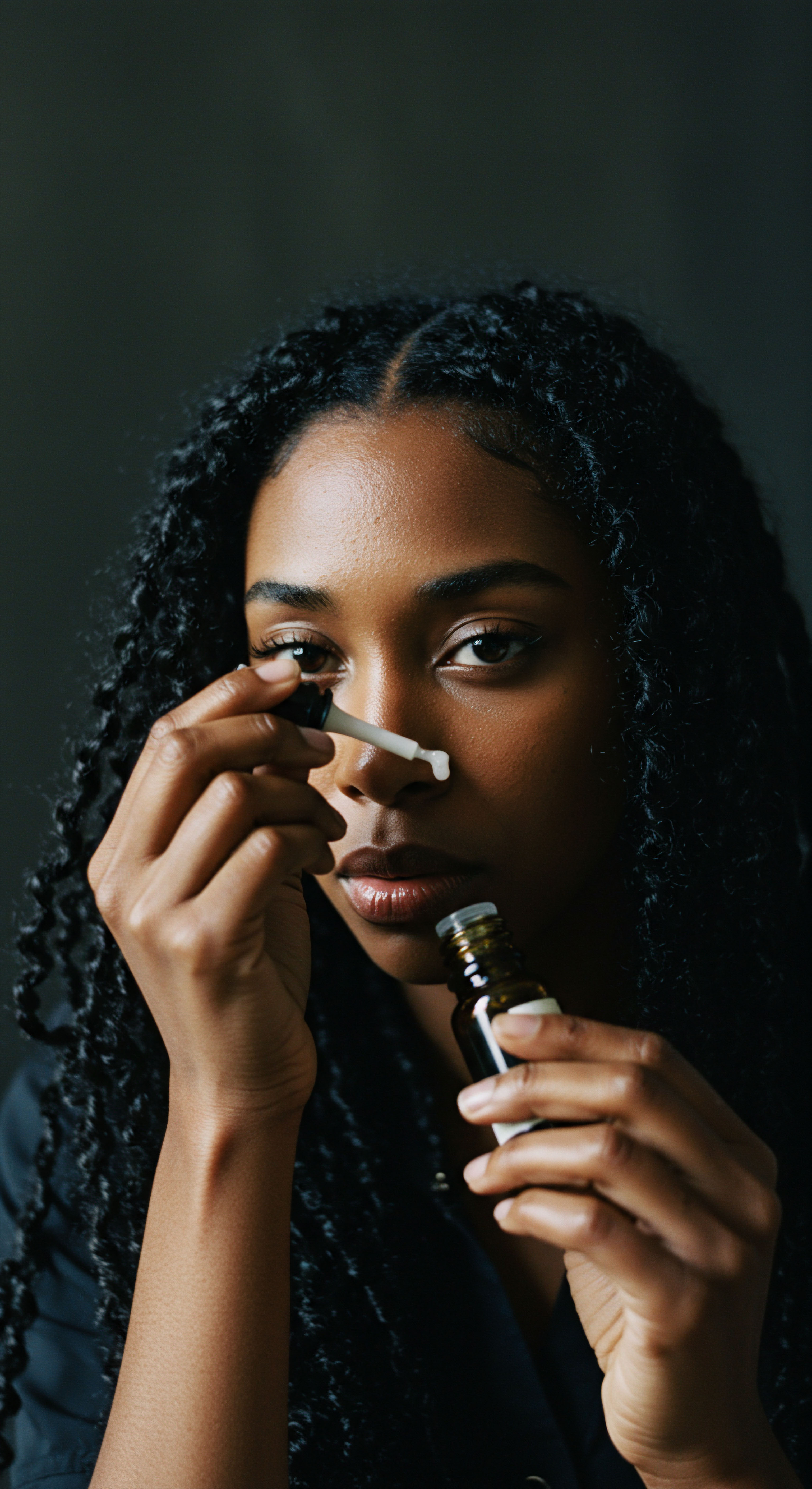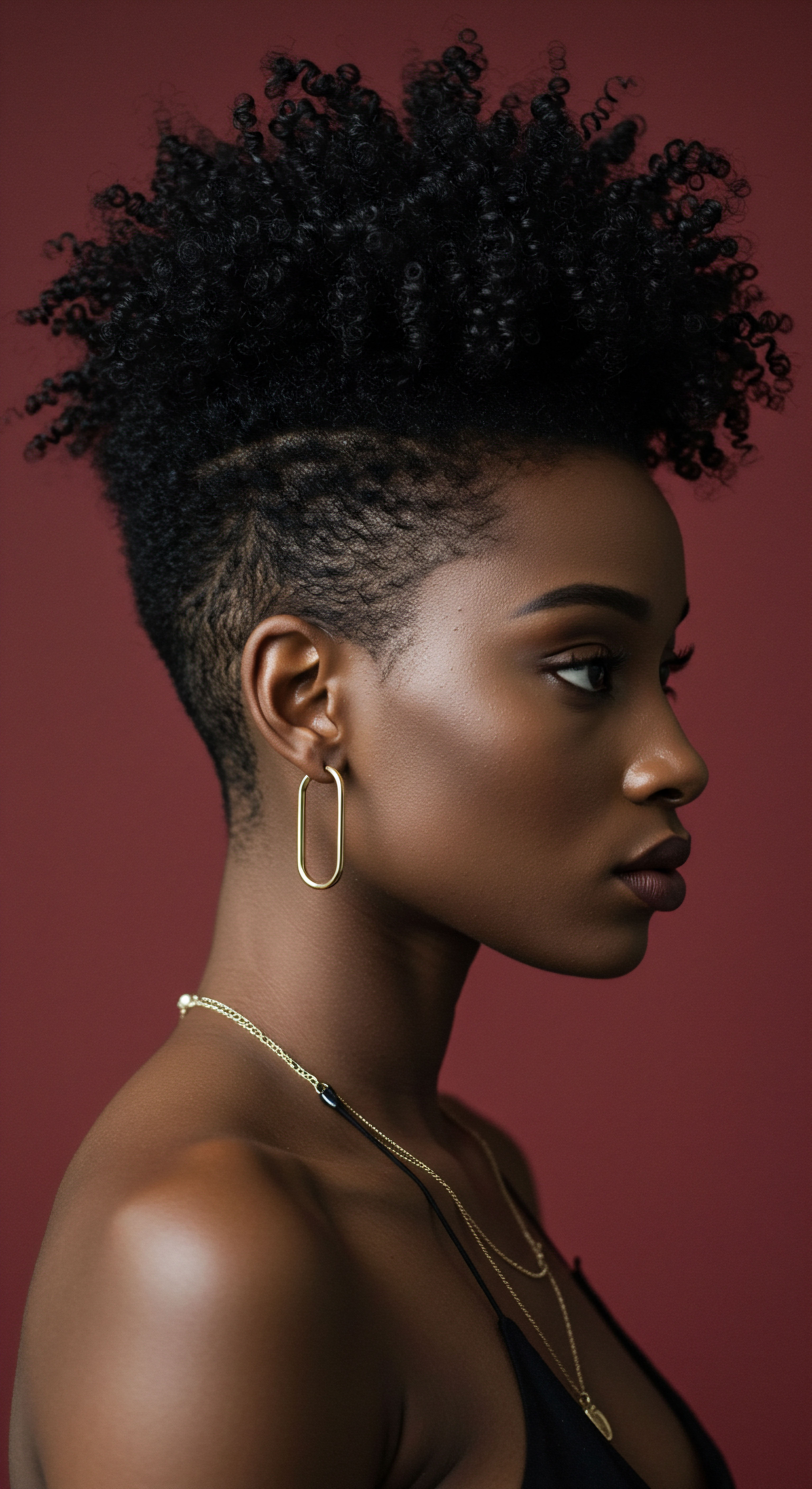
Roots
The quiet hum of history often carries whispers of defiance, particularly when power attempts to dim the light of self-expression. In the vibrant, yet profoundly stratified, colonial New Orleans of the late 18th century, the air was thick with unspoken rules and overt declarations, each seeking to carve out societal roles. Amidst this complex dance of cultures and classifications, the Tignon Laws emerged, a striking decree aimed squarely at the appearance of Black women.
These laws were not merely about head coverings; they were a calculated effort to suppress the visible signs of autonomy, beauty, and economic standing that free women of color had painstakingly cultivated within a deeply unequal society. To truly grasp the essence of this historical moment, one must journey back to the very foundations of power dynamics in that unique colonial landscape, where even a hairstyle could upset a fragile social order.

The Colonial Crucible of Louisiana
Louisiana, particularly New Orleans, presented a distinct social tableau compared to other North American colonies. Under Spanish rule from 1763, after a period of French dominion, the city developed a fluid, albeit rigidly hierarchical, system of racial classification. Here, a significant population of Gens De Couleur Libres, or free people of color, thrived. These individuals, often of mixed African and European heritage, occupied a precarious yet distinct position, navigating a space between the enslaved and the white elite.
Many free women of color, through skill, entrepreneurship, or strategic alliances, amassed property, operated businesses, and built lives of relative independence. Their economic gains and social mobility were often reflected in their public presentation, including their attire and, significantly, their hairstyles.
These women frequently adorned their hair with elaborate styles, often incorporating precious jewels, feathers, and luxurious fabrics. Such displays were not simply matters of personal preference; they were visual declarations of status, cultural pride, and economic success. Their regal bearing and striking appearances, which sometimes blurred the visual lines between them and white women, stirred considerable unease among the white colonial population, particularly white women. The presence of visibly prosperous and elegant free women of color challenged the very underpinnings of a society built on racial subjugation and strict social stratification.
The Tignon Laws were a stark manifestation of societal anxieties concerning racial boundaries and the visible prosperity of free women of color.

Why Were the Tignon Laws Created?
The genesis of the Tignon Laws lies in this escalating social tension. Governor Esteban Miró, the Spanish governor of Louisiana, found himself under increasing pressure from white women and colonial authorities to address what they perceived as a threat to the established social order. The fear was multi-layered:
- Social Competition ❉ Free women of color, with their sophisticated appearance and economic standing, were seen as competing with white women for status and, notably, for the attention of white men. This competition was deeply unsettling to a society that sought to maintain strict racial and social hierarchies.
- Blurring Racial Lines ❉ The elegant dress and hairstyles of free women of color made it difficult to visually distinguish them from white women, particularly those of lighter complexion. This blurring of racial lines was viewed as a direct challenge to the rigid caste system that upheld slavery and white supremacy. The laws aimed to visibly mark them as belonging to a subordinate class, regardless of their actual legal status.
- Control of Appearance as Social Control ❉ Sumptuary laws, which regulate consumption and dress, were not uncommon in the 18th century. In this context, the Tignon Laws served as a tool of social control, an attempt to use external appearance to enforce internal social distinctions. The objective was to return free women of color, symbolically and visibly, to a status associated with servitude.
Thus, in 1786, Governor Miró issued a proclamation, often referred to as the Tignon Laws, mandating that women of African descent, whether enslaved or free, must cover their hair with a headscarf or handkerchief, known as a tignon, when in public. The decree also stipulated that these head coverings should be plain, without adornment of feathers or jewels. The intent was clear ❉ to diminish their public presence, to visually signify their subordinate status, and to reassert the perceived racial hierarchy.

Precursors to the Laws
The Tignon Laws did not emerge from a vacuum. Earlier French laws, such as the Code Noir of 1685 (extended to Louisiana in 1724), had already established a legal framework for racial segregation and the control of Black lives. These codes, while primarily regulating slavery, also laid the groundwork for defining racial categories and restricting the lives of people of color.
The Tignon Laws represent a specific extension of this broader legal and social project, focusing on appearance as a direct means of enforcing racial and class distinctions in a visually driven society. The legal system had long been a mechanism for defining who belonged and who did not, and the Tignon Laws stand as a stark reminder of how deeply embedded racial control was in the very fabric of colonial life.

Ritual
The rhythms of daily life often hold the deepest truths, particularly when those rhythms are challenged by external forces. When the Tignon Laws descended upon New Orleans, they sought to disrupt the personal rituals of self-presentation that Black women had cultivated, aiming to replace vibrant self-expression with enforced humility. Yet, within this attempt at control, a remarkable spirit of adaptation and quiet resistance bloomed.
The story of the tignon, therefore, is not merely one of legal mandate, but of the ingenious ways women transformed a symbol of subjugation into a banner of enduring style and cultural pride. This section delves into the practicalities of these laws and the immediate, personal responses they elicited, revealing how daily acts became profound statements.

The Daily Practice of Compliance and Resistance
The decree was simple in its instruction ❉ Black women were to wear a tignon, a head covering, and refrain from adorning their hair with the customary feathers and jewels. For many, this meant a tangible shift in their morning routines, a deliberate act of concealment where there had once been celebration. However, the women of New Orleans, particularly the free women of color, possessed a resilience that proved more potent than any legislative attempt at suppression. They complied with the letter of the law, yet subverted its spirit with astonishing creativity.
Instead of drab, plain coverings, these women sought out the most luxurious fabrics available ❉ silks from India, fine laces, and vibrant cottons. They learned and innovated complex tying techniques, creating sculptural headwraps that became works of art in themselves. These were not simple scarves; they were elaborate, voluminous turbans, sometimes rising high, sometimes intricately folded, each a testament to individual artistry and collective defiance. Even the forbidden jewels and feathers sometimes found their way onto the fabric of the tignon, rather than directly in the hair, subtly skirting the exact wording of the law while maintaining a visual statement of wealth and personal style.
The ingenious adaptation of the tignon transformed a symbol of intended subservience into an undeniable mark of cultural pride and individual artistry.

How Did Women Subvert the Law’s Intent?
The impact of this creative resistance was undeniable. The very object intended to diminish them became a powerful symbol of their presence and refusal to be erased. The elaborate tignons, far from making them appear subservient, often enhanced their striking appearance, drawing even more attention.
Consider the often-overlooked economic dimension of this resistance. While precise statistics on the cost of these defiant tignons are scarce, historical accounts suggest that free women of color, many of whom were already economically active, continued to invest in high-quality materials for their head coverings. Some historical anecdotes even recount instances where White Suitors or Partners of free women of color would acquire expensive fabrics and adornments from international trade routes for them to use in their tignons, a direct, albeit subtle, economic and social subversion of the law’s intent to diminish their perceived wealth and attractiveness.
This practice not only maintained their visual splendor but also demonstrated a continued flow of resources into their self-presentation, despite the legal restrictions. This historical detail underscores how personal choices, even in the face of legal constraint, can become powerful acts of economic agency and social statement.
| Aspect of Control Mandated Hair Covering |
| Woman's Response Adopted headwraps made from luxurious, vibrant fabrics. |
| Aspect of Control Prohibited Adornments |
| Woman's Response Incorporated jewels, beads, and feathers onto the fabric of the tignon itself. |
| Aspect of Control Intended Humiliation |
| Woman's Response Developed intricate, sculptural tying techniques that enhanced beauty. |
| Aspect of Control Enforced Social Subordination |
| Woman's Response Transformed the tignon into a symbol of cultural identity and defiance. |

The Cultural Legacy of the Tignon
The tignon, therefore, ceased to be solely a mark of enforced distinction and became a marker of identity, resilience, and a distinctive New Orleans style. This transformation highlights a profound aspect of human spirit ❉ the capacity to find beauty and agency even within restrictive frameworks. The styles became so iconic that they long outlived the official repeal of the Tignon Laws after the Louisiana Purchase in 1803.
The ritual of tying the tignon, selecting its fabric, and arranging its folds became a daily affirmation of selfhood and cultural heritage. It was a silent conversation between past traditions and present defiance, a practical act steeped in historical memory. This practice reminds us that care rituals, even those seemingly simple, carry profound weight, connecting individuals to their lineage and their collective story.

Relay
Beyond the immediate acts of personal adornment and daily adaptation, the Tignon Laws set into motion deeper currents that continue to ripple through discussions of identity, beauty, and social control. To truly grasp the breadth of their impact requires a journey into the less visible, yet profoundly influential, realms where legal mandates intersect with psychological fortitude, cultural preservation, and the enduring politics of appearance. This section seeks to peel back the layers of surface-level understanding, delving into the systemic implications and the lasting lessons that this historical episode offers about the interplay of power, race, and selfhood.

What Did the Tignon Laws Reveal About Societal Power Structures?
The Tignon Laws, while ostensibly about dress, laid bare the raw anxiety of colonial authorities concerning the erosion of racial hierarchies. The very existence of free women of color who could achieve economic independence and social standing posed a direct challenge to the fundamental premise of a slave society ❉ that Blackness equated to servitude and whiteness to freedom and superiority. Historian Virginia M. Gould notes that Governor Miró’s efforts aimed to control women who “competed too freely with white women for status and thus threatened the social order.” This indicates that the laws were less about morality and more about maintaining a rigid caste system.
The legislation was a strategic attempt to re-subordinate free women of color by visually associating them with the enslaved population. This act of forced visual alignment served to reinforce a societal narrative that denied agency and upward mobility to those of African descent. The laws exemplify how appearance, particularly hair, can be weaponized by dominant groups to exert control, hypersexualize, and de-feminize marginalized communities, a pattern that unfortunately extends across centuries and geographies.
- Visible Markers of Subordination ❉ The mandate to cover hair was a public declaration of racial difference and intended inferiority.
- Economic and Social Threat ❉ The prosperity and social fluidity of free women of color challenged the economic dominance and social standing of white women.
- Racial Purity Ideology ❉ The laws reinforced a system where “passing” as white or achieving status similar to white individuals was seen as a threat to racial purity and the existing power structure.

How Did the Laws Impact Identity and Self-Perception?
Despite the oppressive intent, the Tignon Laws inadvertently strengthened a collective identity among Black women in New Orleans. The mandated head covering became a shared experience, a visible symbol of their unique position and their shared heritage. The creative subversion of the tignon meant that what was meant to be a badge of shame transformed into a statement of defiance and beauty. This act of reclaiming the symbol speaks volumes about the psychological resilience required to navigate such restrictive environments.
The process of styling the tignon, of selecting its fabric and arranging its folds, became an act of self-definition. It was a daily ritual of reclaiming agency, even if only within the confines of a mandated accessory. This deep connection between personal presentation and inner selfhood is a recurring theme in the history of Black hair, demonstrating how hair and its adornment are rarely superficial; they are often profound expressions of identity, resistance, and cultural continuity.

Enduring Echoes in Contemporary Hair Politics
The legacy of the Tignon Laws resonates even today in the ongoing discourse surrounding Black hair. Policies and societal norms that dictate “professional” or “acceptable” hairstyles often mirror the underlying principles of the Tignon Laws ❉ an attempt to standardize appearance to a Eurocentric ideal, thereby marginalizing natural Black hair textures. The continued fight for hair freedom, seen in movements and legislation like the CROWN Act, directly links back to these historical attempts to control Black women’s appearance.
The enduring significance of the tignon lies in its ability to serve as a powerful reminder of how Black women, time and again, have transformed instruments of oppression into symbols of cultural pride and self-determination. The historical precedent set by the Tignon Laws highlights that debates about Black hair are rarely just about aesthetics; they are deeply rooted in discussions of race, power, and the right to self-expression.
| Historical Context Tignon Laws 1786 |
| Psychological Impact Attempted public humiliation, forced subordination. |
| Cultural Response Creative defiance, re-appropriation of headwraps as fashion statements. |
| Historical Context Post-Slavery Era (19th-20th Century) |
| Psychological Impact Pressure to assimilate to Eurocentric beauty standards (straightened hair). |
| Cultural Response Internalized self-perception struggles, but also continued traditional practices in private. |
| Historical Context Civil Rights Movement (1960s-70s) |
| Psychological Impact Rejection of assimilation, political statement through natural hair. |
| Cultural Response Afro as a symbol of Black Power, pride, and identity. |
| Historical Context Modern Era (21st Century) |
| Psychological Impact Workplace discrimination, microaggressions against natural hair. |
| Cultural Response Natural hair movement, CROWN Act legislation, self-acceptance, and empowerment. |
| Historical Context This table illustrates a continuous pattern of control and resistance related to Black women's hair across different historical periods. |

Reflection
The story of the Tignon Laws is a profound reminder that the history of hair is rarely trivial; it is often a powerful chronicle of human dignity, resistance, and the relentless pursuit of selfhood. What began as a decree intended to diminish became, through the spirit of those it targeted, a vibrant expression of cultural tenacity. The elaborate headwraps of New Orleans’ free women of color stand as a testament to the enduring human capacity to find beauty and agency even when faced with attempts to control one’s very appearance. Their legacy whispers through generations, a quiet assurance that authenticity, once deeply rooted, can always find a way to bloom.

References
- Byrd, Ayana and Tharps, Lori. Hair Story ❉ Untangling the Roots of Black Hair in America. St. Martin’s Press, 2001.
- de la Fuente, Alejandro and Gross, Ariela J. Becoming Free, Becoming Black ❉ Race, Freedom, and Law in Cuba, Virginia, and Louisiana. Cambridge University Press, 2020.
- Gould, Virginia M. The Devil’s Lane ❉ Sex and Race in the Early South. Oxford University Press, 2002.
- Greensword, Sylviane. “Historicizing black hair politics ❉ A framework for contextualizing race politics.” Sociology Compass, vol. 16, no. 8, 2022.
- Hall, Gwendolyn Midlo. Africans in Colonial Louisiana ❉ The Development of Afro-Creole Culture in the Eighteenth Century. Louisiana State University Press, 1992.
- Klein, Sybil. Creole ❉ The History and Legacy of Louisiana’s Free People of Color. Louisiana State University Press, 2000.
- Winters, Lisa Ze. The Mulatta Concubine ❉ Terror, Intimacy, Freedom, and Desire in the Black Transatlantic. University of Georgia Press, 2015.